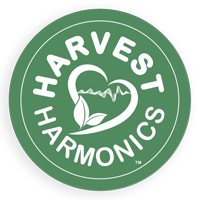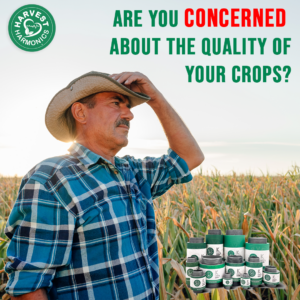Lava Terrace and Harvest Harmonics
by LD Sledge
“I had the pleasure and good fortune to meet and interview Duane and Dina Barker, two extraordinary people whom I consider models for creativity and survival.
Where the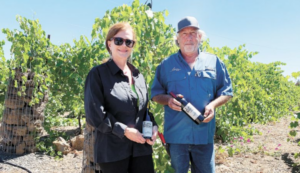 y are today and how they got here.
y are today and how they got here.
In 2020 they entered their first two wine competitions resulting in six medals and international recognition.
At the 2020 Sunset International Wine Competition, Lava Terrace Cellars received silver medals for its 2017 Barrel Aged Marechal Foch and 2018 La Crescent. The 2020 San Francisco International Wine Competition awarded silver medals for its 2018 Reserve – One Barrel Marechal Foch and 2019 Marquette, and bronze medals for its 2018 and 2019 La Crescent. (Lifted from Lava Terrace Cellar’s Website)
Since that last report above, they won 9 medals out of 11 entries. The latest was the Newport Seafood and Wine festival. They also won a Silver medal 2020 Marechal Foch… 2021 Marquette Rose.
How did they get to this place in the wonderful world of wine.
Duane was born in 1955 and grew up in Carmichael, a Sacramento suburb. He worked with his dad in Coca Cola in high school and after graduation drove a Coke route for three years. Later he was offered a position as branch manager with the company in Bend Oregon but didn’t care for the executive corporate life. Later he and his wife Dina started a promotion company https://BrillianceinBranding.com, which took off.
Evolution
They bought five acres in the Bend area, the dry side of the beautiful Cascades. At a 3500 foot elevation these five acres were in an arid land of sage, volcanic outcroppings and lava soil composition. They saw potential at being what was the best life they could live as independent people with a sustainable lifestyle. This doesn’t mean “off the grid,” but as close as he could get and still manage their branding business and stay connected to modern conveniences and contribute to society.
Sustainable Living and Farming
The Definition of Sustainable Living: It is the practice of making conscious lifestyle choices that reduce a person’s impact on the environment. Individuals who embrace sustainable living philosophies aim to reduce their carbon footprint and conserve Earth’s resources.
He expanded this to the ability of his farm system to produce food and other products indefinitely without damaging or depleting the resources on which it depends.
These goals and practices are more than just noble. They make infinite sense and can mean the survival of the species by keeping our land alive, and not murdered by chemicals such as fertilizers and poisonous insecticides and weed killers such as Round Up. Duane is almost religious in his desire to leave as small a “carbon footprint” as possible. Carbon footprint is “a measure of the amount of carbon dioxide and other carbon compounds emitted due to the consumption of fossil fuels by a particular person, group, etc.”
And he achieved this goal. As a result the land is enriched and all things recycled and rotated and made better and better.
His Sustainable Farm
Forty eight solar panels were installed so they were independent of major external energy sources for lighting, etc. A dozen head of cattle, 21 chickens and four pigs and a large garden was a good start. They grew potatoes, corn, asparagus, cucumbers, peppers, beets, squash, broccoli and carrots. It is a very short growing season, so he had to really work these plants to make them produce. The sustainable farm was sustaining happily.
Grapes
Duane says:
“We did not get into the wine business as a goal… it happened like this. We have always tried to grow / raise our own food. Gardens, cows, chickens, pigs etc. My neighbor asked me if I wanted to go learn about wine grapes at an OSU extension outreach meeting at the first vineyard put in in our area. I went along, told my wife about it and she said, ‘great, I will order some vines’. Twenty-five Pinot Noir, 25 Marechal Foch. I planted them in an area that was not used for anything else, rocky desert ground …. 3 years later, I had grapes. I did not know much at all about growing grapes but figured it out as I went along. YouTube, podcast etc. I caught the wine bug. I bought a small compact Kubota Tractor back in 2014 and have been planting vines ever since. From those first 50 vines, we are now around 4000 on 5 acres. 5 varieties. I have learned how to do all the steps in the vineyard to grow these grapes successfully over the last 10 years.”
They rolled the dice. They knew they would take a long time to make a successful crop of grapes, usually 6 or 7 years. But they instinctively knew that they could, and would, make it happen.
Lava Terrace Cellars was born. www.Lavaterracecellars.com)
Hybrid Grapes
Having made a study of what might work at this altitude and in this soil, in 2012 they chose two hybrid varietals, Marechal Foch and Pino Noir. Loving the taste and romance of wine history, Duane and Dina knew the old standards used in France with a regular predictable environment and temperature would not make it in their climate and soil, but varietals were hardy and had a chance of survival. They were aware that the horrendous polar vortex could mean devastation, but they took a shot anyway. Sure enough, Marechal Foch flourished and only 4 of the Pinot made it and those 4 are still making good wine.
More vines added in 2014
Next, in 2014, they added La Crescent, Brianna, more Marechal Foch and Marquette, amounting to 4000 vines, and since they haven’t looked back. They enhanced the new Vineyard area by putting in a drip system, rich compost, strong posts, and everything needed to convert the sage, lava rocks and poor earth to the ideal in grape cultivation. The pigs and chickens were allowed to rove the vineyard. They served to keep it weed and insect free and fertilized the area.
Crop Booster™ Is Introduced
Wanting to constantly improve all phases of anything they create, they decided to take a chance on the raves they read about Harvest Harmonics’ innovative product, the Crop Booster.
The First Year of Crop Booster Use
This year was a horrendous one for any farmer. A hailstorm of monumental proportions struck the farm. The nickel and quarter size hailstones pouring from the skies with great force and pulverized the new green shoots which scarred their tissue for the following season. This effected all the new wood from that year that could not be used as fruiting canes for the following year.
The Second Year
Everything was restored as best they could for the next year’s crop, but again, there was a polar vortex that “messed up” the entire valley. But in spite of this, the vines recovered in a spectacular way and they had a good crop with good fruit. The clusters were noticeably larger than previous years. The berry size was twice the size of those in neighboring vineyards. Neighbor’s grapes averaged .05 grams in size and Lava Terrace fruit 1.1 grams. The attached picture speaks loudly of this incredible result. Note the fullness and tightly packed clusters of the Crop Booster product. The fruit load per vine was increased noticeably and had an extraordinary rich taste more than usual.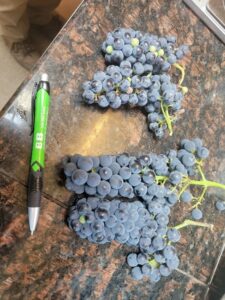
The second year wood is much thicker than previously and will provide necessary structure for a great crop for the 2023 vintage. Pruning this season has be a cake walk compared to the previous year.
The soil, rather than being hard, was actually spongy and the water wouldn’t evaporate as fast allowing the water to feed the plants longer, resulting in less water required. And there is no use for fertilizer, weed killer or insecticides. The only thing added was at planting when they put in time release Osmocote, and some other natural nutrients to feed the vines to start. The vines themselves are neater, and more orderly and uniform.
Other Crops
They used the Crop Booster in their garden area, and look at the height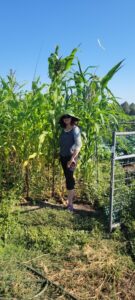 of the corn. The height was half again the norm, (from an average of 6’ to 10’) and the stalks were loaded with heavy juicy ears of corn.
of the corn. The height was half again the norm, (from an average of 6’ to 10’) and the stalks were loaded with heavy juicy ears of corn.
Vegetables. The crops usually have a 3-4 week harvest, but the asparagus kept growing into 2-2/2 months, each harvest of the spears would be followed by another and there usually is only one harvest. Peppers were large, like 2 ½ inches, and they got 30 pints.
Here is what Duane has to say about the difference
“Here is a list of what I have noticed: First of all we have gone to almost no spray of any kind. I only have had to spray for one insect–Leaf hopper and it has been targeted areas. No herbicides or chemical fertilizers.
Certain grape vines that were planted without much compost in the past struggled more than other. I saw those vines vigor increase doing nothing else different.
Second year wood. Second year wood is where the grapes clusters are in buds for the upcoming season. I really noticed this year while doing pruning that the canes are thicker, healthier than in the past. This is good as it will lead to a better crop load.
Soil health: What I have noticed is that where we have good organic material in the soil, the better the vines react to the system. I have noticed that a more balance eco-system is developing in the vineyard. The weeds are now competing with each other as well as planted white clover. No one variety of weed is in charge so to speak as in the past. Fungi are appearing more and more in the form of mushrooms etc. We do inoculate the vine starts with Micorrhizae to help with soil health. I am also seeing more beneficial insects , daddy long legs, lady bugs , earwigs, praying mantis. Birds like mourning doves have decided to spend more time wintering in the vineyard. We have introduced a flock of chickens and 4 Kune Kune pigs too, they eat weeds, grasses and naturally fertilize the soil.”
The Future
Duane and Dina have plans of expanding vineyard sites and their wine tasting room. They now sell 500 cases of wine per season. The goal is to sell 2000 cases and have a residual income. But I cannot see these two retiring. They will always be dynamic, producing something and actively producing something. They are creative people and such folks never stop making things happen.
